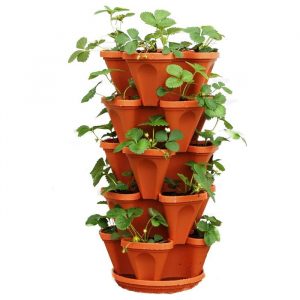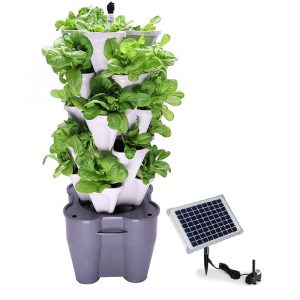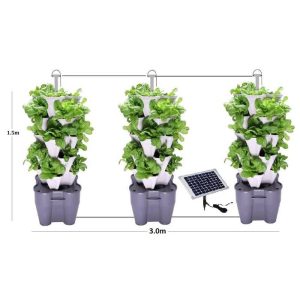Freestanding Vertical Gardens Australia
Vertical Herb Gardens
Vertical Vegetable Gardens
We’re confident that you’ll be hard pressed to find a better freestanding vertical garden system in Australia. Our vertical gardening systems produce excellent yields in small urban gardening spaces and we know from experience that they’re the best on the market.
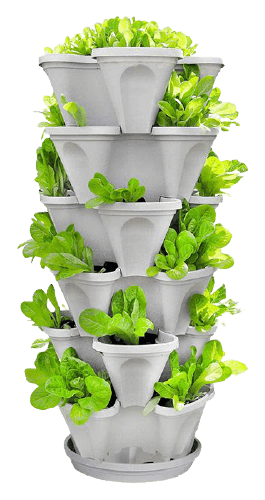
Freestanding Vertical Gardens
You won’t find this kind of quality vertical garden at the big green warehouse.
- Sale!
Vertical Garden Planters
- Freestanding Vertical Gardens
- $55.00 – $222.00 inc. GST
- Select options This product has multiple variants. The options may be chosen on the product page
- Sale!
Hydroponic Vertical Garden
- Freestanding Vertical Gardens
- $429.00 – $449.00 inc. GST
- Select options This product has multiple variants. The options may be chosen on the product page
3 Tower Hydroponic Vertical Garden
- Freestanding Vertical Gardens
- $895.00 inc. GST
- Select options This product has multiple variants. The options may be chosen on the product page
What Are Vertical Gardens?
Vertical gardens are an excellent way to grow your own herbs & vegetables by stacking layers of vertical planters on top of each other. Using stacking planters, this method requires less space and can produce significantly more yield than traditional gardening methods. Vertical garden pots use less water and will often require less maintenance.
A stackable vertical garden is designed to maximise your tower garden’s productivity and reduce water usage whilst providing excellent results with minimal effort. Our vertical gardens are suitable for use as both hydroponic vertical gardens or tower gardens using standard soil. We know that our range represents the best vertical garden kits Australia has to offer. You’ll get everything you need to get your vertical vegetable garden started, including excellent Australian support. We know our tower gardens stack up very well against any freestanding vertical garden Bunnings has available.
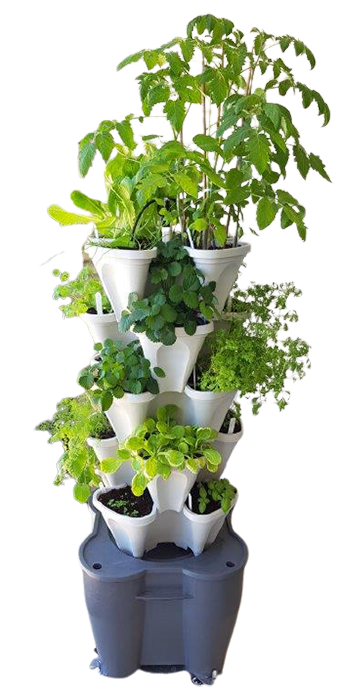
Vertical Garden Frequently Asked Questions
Do vertical gardens work?
The are many benefits to using a vertical garden for growing your herbs, vegetables & fruits. You’ll be able to generate a much larger yield from your plants in a smaller space because of the stacking nature of the vertical garden. If you’ve got limited space or you’re interested in urban farming you’ll be pleasantly surprised by the results these vertical garden pots generate over and above traditional herb & vegetable gardens. We’re confident that you’ll find that these are the best vertical gardens Australia has to offer.
How does a vertical garden work as a system?
A vertical garden system is used to grow plants vertically using freestanding stacking planters that use either a hydroponic growing medium or standard soil. The vertical garden system is watered from the top and the water and nutrients will trickle down through the vertical layers to reach all of the levels in your vertical garden system. Vertical garden systems can be freestanding or attached to a wall and both types have their advantages. We find that the freedom of freestanding vertical gardens is excellent and requires less effort to install.
What grows well in a vertical garden?
Our customers have had great success with growing many varieties of herbs, vegetables & fruit in our freestanding vertical gardens. See the table below for a small selection of some of the foods that can be grown in a vertical garden. Vertical garden ideas are really only limited to what you can safely support in your grow area.
| Plant Type | Plant Details |
|---|---|
| Vegetables | Lettuce, Spinach, Kale, Celery, Capsicum, Beans, Swiss Chard, Carrots, Cucumbers, Eggplant, Garlic, Onions, Chillies, Tomatoes, Beet Root, Potatoes & Pumpkin. |
| Herbs | Coriander, Basil, Chives, Oregano, Parsley, Cumin, Beebalm (Bergamot), Borage, Chervil, Cilantro, Dill, Lemon Balm, Lemon Grass, Marjoram, Mint, Nasturtium, Rosemary, Sage, Savory, Stevia, Thyme & Wheat Grass plus many others. |
| Fruits | Strawberries, Small Melons |
Can you grow herbs in a vertical herb garden?
Our freestanding vertical garden systems are an excellent solution for a vertical herb garden. As we all know buying herbs from the supermarket can be both expensive and sometimes wasteful when we don’t require the whole herb for our recipes. The advantage of being able to walk out into your backyard, patio or balcony and harvest what you need form your vertical herb garden is convenient and efficient. You’ll be able to successfully grow herbs like Coriander, Basil, Chives, Oregano, Parsley, Mint, Cumin, Beebalm (Bergamot), Borage, Chervil, Cilantro, Dill, Lemon Balm, Lemon Grass, Marjoram, Mint, Nasturtium, Rosemary, Sorrel, Sage, Savory, Stevia, Thyme & Wheat Grass plus many others.
Can you grow Carrots in a vertical garden?
You will definitely be able to grow carrots in a vertical garden and you’ll generally get more yield than you would growing in the ground. Some root vegetables like carrots may not turn out quite a straight when grown in a vertical garden, however they will just as nutritious if not more nutritious than those grown in the ground. Another benefit is that as a rule of thumb you would need approximately 13 to 18 times more space on the ground compared to what you’ll be able to grow in your vertical garden.
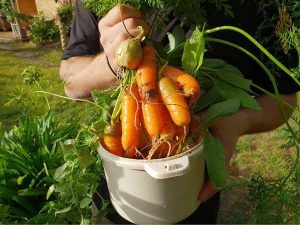
Are these vertical planters suitable for a vertical vegetable garden?
Many of our customers are looking for an efficient and cost effective vertical vegetable garden. We know from experience that all manor of vegetables can be abundantly grown in a vertical garden. Providing you have enough sunlight you’ll be able to grow an excellent variety of vegetables in your vertical vegetable garden. Some examples of the vegetables that we’ve successfully cultivated are Lettuce, Spinach, Kale, Celery, Capsicum, Beans, Swiss Chard, Carrots, Cucumbers, Eggplant, Garlic, Onions, Chillies, Tomatoes, Beet Root, Potatoes & Pumpkin.
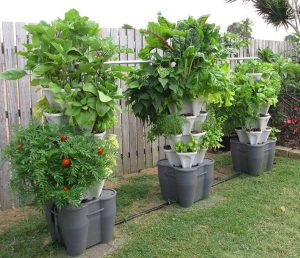
What is a hydroponic vertical garden?
A hydroponic vertical garden is a way to grow herbs, vegetables & fruits without soil by stacking the plants in layers on top of each other. It’s important to ensure that each layer in your hydroponic vertical garden gets enough sunlight and adequate air flow. Our customers will generally grow their plants in a medium of Coco Coir Pete and Perlite (natural volcanic glass) at a a ratio of 80% Coco Coir to 20% Perlite. This ensure that the plants get enough aeration around their root systems and adequate drainage to prevent root rot. Hydroponic vertical gardens have a lot of advantages over traditional gardens. These advantages include:
- Greater yield on your herbs & vegetables per square meter of growing area compared to traditional horizontal ground gardens.
- Excellent for urban farming where space is limited and because we sell freestanding hydroponic vertical gardens they’re perfectly suited to growing in backyards, balconies, patios and rooftops.
- Up to 90% more water efficient, especially when using recirculating hydroponic systems.
- Hydroponic vertical gardens also eliminate the risk of soil borne diseases.
- Allows you to grow all year round depending on your region’s climate and allows you to grow indoors.
Can these vertical garden systems be used outdoors?
Are vertical gardens easy to maintain?
Our vertical garden systems are very simple to maintain. Because of their excellent freestanding design you can access all of your herbs & vegetables easily and monitor their progress easily. You’ll save your back because you won’t have to bend down constantly for weeding and inspection. Water the vertical gardens is a simple as watering the top tier of the stack and allowing the water and nutrients to trickle down to the layers below. If you purchase one of our heavy duty trollies, you’ll also be able to easily relocate your vertical garden as you see fit.
Can you grow tomatoes in a vertical garden?
A vertical garden is an excellent way to grow tomatoes. As with any successful vertical garden, growing tomatoes will require good sunlight (approximately 6 hours per day) and tomatoes also like a lot of water. You’ll find success growing your tomatoes with a vertical garden and it will be likely that the tomato vines will need a little extra support just like they would if you were growing tomatoes traditionally.
How do I water my vertical garden?
Watering your vertical garden is very easy. You simply water the top layer of your tower garden and the water and nutrients will filter down through each successive layer of your vertical planters. Each level has been designed will drainage holes at both the centre and the outer areas of the layer to ensure that all of your plant’s root system are able to access the nutrients that they need. Our vertical garden design ensure that water will not pool and helps prevent any root rot.
Are the vertical planters made from food safe material?
The short answer is yes. The stackable layers are made from Polypropylene (5) which one of the most inert plastics available. This is the type of material that you’ll find used in food storage for yogurt in the supermarket. Additional the vertical garden system has been UV treated to ensure durability over the long term.
Is there a difference between a vertical garden and vertical planters?
There is no real difference between a vertical garden and vertical planters. They are really just different names for the same type of vertical gardening system.

